RedNeckGeek
Super Member
- Joined
- Jan 1, 2011
- Messages
- 8,754
- Location
- Butte County & Orcutt, California
- Tractor
- Kubota M62, Kubota L3240D HST (SOLD!), Kubota RTV900
This is the third installment of a review of the Ariens 22 ton log splitter I'd recently taken delivery of at Home Depot. Find the other parts by searching in Rural Living for "Ariens 22 Ton Log Splitter Review".
I had an hour or so to kill late this afternoon so I dug the Ariens 22 ton log splitter out of the trailer and towed it up to the garage. Again I was impressed that the thing stayed upright on the steep side hills and uneven ramp of the trailer and am feeling a lot more comfortable about moving it around the property.
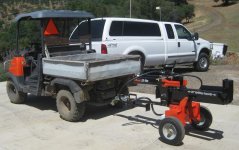
All it needed was hydraulic oil and fuel and I started with the hydraulic oil. Pretty straight forward: Remove the filler plug (which has a dip stick attached), insert a funnel, and fill the tank. The oil came in a 5 gallon pail with a pour spout in the lid, so I managed to get all of the oil in the tank without spilling any. it's probably worth mentioning that on delivery, the tank plug was threaded in less than finger tight and I consider myself lucky that it was there at all. On the other hand, the plug and dip stick are nicely plated and very sturdy. Like most hydraulic oil I've seen though, it's pretty difficult to tell where the level is on the stick. I found it easiest to wipe the stick clean, dip it, then use my finger to feel where the oil started.
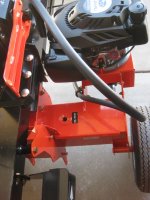
Next up was fuel. I liked the way that the cap to the tank was tethered to the tank, and that the cap threaded around the outside of the filler neck so that water and dirt would be kept out. The cap itself features a built in ratchet mechanism so that it can't be over tightened, and it's marked with an ethanol limit. I use E0 (ethanol free) fuel that has Stabil added for good measure. And I've gotten into the habit of always running my gas engines dry when I'm done so there's no fuel in the carb to gum up the works. I never know how long it's gonna be until the next time I use something. There's also a built in screen to filter fuel as it's added to the tank. Nice.
I was using one of those awful five gallon fuel containers with the government mandated pull back spout and after only a few seconds the tank overflowed. It only holds 1.2 quarts, and if I'd read the manual in advance I'd have been a little more careful. As was, though, the fuel just ran over the outside of the fuel tank, and not all over the rest of the splitter.
With the cap back on it was time to fire it up. There's an in line fuel shut off valve, very handy for running the carb dry at the end of the day. It's easy to reach and worked smoothly. The valve has a single flat blade handle: set it across the fuel line to shut off fuel flow, parallel gets the fuel going. Simple and intuitive, just the way it should be. The valve is right next to the choke handle, which has detents at full on and full off, but which can be set at any position in between. I set it to full on. Right next to that is the ignition switch, marked "0" and "1". Flipped to "1", I was ready to try the pull starter. I didn't know how long the cord was, so I gave it a gentle pull until the piston came up to compression, then a little harder tug to try to start it. Nothing happened. So I gently pulled the cord until it was all the way out, finding a generous amount of cord that would allow a real manly pull. And that's all it took, one manly pull and the motor roared to life. Well stuttered may be more accurate, as it was ninety degrees out and the choke probably wasn't necessary. So I shut it off and the RPMs increased as the engine smoothed out. I didn't notice any surging or bouncing off a governor, and it was quiet enough that I decided not to use ear muffs. No one else was around, but I think you could easily hold a conversation when standing right next to the running motor. During the restarts that occurred the rest of the session I didn't use the choke and all it ever took to start is an easy one handed pull on the cord. We were off to a great start.

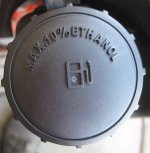
With the motor running I cycled the ram half a dozen times, making sure to briefly overpressure the system at each end of travel. If it was gonna leak I wanted it to do it in the garage and not out by the wood pile. That done I shut of the motor and checked the tank level again. It was really low, but then I noticed that the ram was fully extended. Glad I didn't try to add more oil at that point, as I'd have had oil all over the floor, or maybe even burst the tank. So I started the motor back up with a single pull, retracted the ram, verifying that the valve handle stuck in the retract position, then automatically shut itself off when the ram bottomed out in the cylinder. Nice. With the motor off again the level was still a bit low so I poured another few quarts in to bring it up to mid dip stick. I'm guessing it's got a little more than four gallons in it from what is left in the bucket. The dip stick went back in with a few wraps of teflon plumber's tape on the threads, then I ran my fingers over each of the hydraulic lines looking for leaks. Two of them were wet with fluid and it looked like it was coming from where the ferrels were crimped onto the hoses. But I wasn't absolutely certain I hadn't spilled a bit of fluid from the funnel while I was filling the tank, so I used some contact cleaner and a paper towel to clean everything up.
Off we went to the wood pile, where I backed the splitter next to a little pile of wood I'd bucked up a couple weeks previously. I chocked the wheels with bits of wood, unhitched, then moved the RTV around to the side so I could easily reach the bed and stack the splits. All I had in my pile was oak, a mixture of what the locals call white oak and live oak. Most was several seasons old, but some came from a tree that had blown down last winter. There was everything from straight grained chunks to twisted sections cut from just above the roots and quite a few crotches where branches had been trimmed off. Nothing was more than about a foot in diameter, and only about half of it had the ends cut square to the log (I'm still learning).
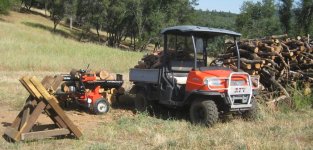

I figured I'd start with something easy and picked up chunk of wood about eight inches in diameter and the same length. It was heavy for its size, but what I didn't notice is that the grain ran diagonally through the piece. There were no cracks in the cut surface of the piece, so I just centered the wedge on it and hit the lever. It advanced, momentarily stalled, then slowly moved through the piece. I could here the motor strain as it the pump loaded, then ease off as the log broke and the wedge advanced. I was a little surprised at this, but then I noticed the twisted grain, and that the wedge had actually sheared it's way through the log instead of splitting it. I picked up one of the halves and split it, this time watching the wedge move steadily through it with no pauses.
Next I picked up a pretty big piece with a crotch at one end. Even though it was less than a foot in diameter, it was one of the biggest pieces of wood I'll be running into, and I figured if the splitter made it through that I'd be OK with anything else I'd use it for. I took a short movie of the split, and of another piece of the green oak as well. In both shots, the wedge advanced then paused. I flipped the handle back momentarily and when the valve opened again the wedge moved forward to finish the split.
[video]https://www.youtube.com/edit?o=U&video_id=fEthmy7X9rs&feature=vm[/video]
Not a real he-man performance, but good enough for the girls I go with. Those logs were heavy for their size, so I went back to the shop and got my moisture meter. It's a Lignomat mini Ligno E, an Amazon purchase with pretty good ratings. First one I've ever had, and it told me the outside of the wood was at about 8% water, but the inside measured anywhere between 14% and 22%, the highest the thing went. The splits were stringy as well, another sign that the wood was wasn't well seasoned, and probably from last winter's blow down. I'm guessing that the splitter will pick up a little strength as it breaks in as well. In any case, I split another couple dozen pieces in the next hour, breaking them down into two to four inch cross sections. I'm also new to wood burning stoves at this point, and am not really sure what sizes I'll be needing. But I used the splitter enough to get a feel for it, and from what I see so far, I really like it. The ram height is great as I can move wood on and off of the beam without having to bend over or stoop my shoulders. I also learned that a log can fly off the beam if it isn't positioned properly, so next time I'll give myself a little more room between the splitter and the wood pile so I can stand next to the ram instead of the wedge. The log cradles do a great job of catching the splits as they come off as well. As mentioned earlier, the control valve is easy to reach and works without any fuss. I didn't have any issues with the splitter moving or the beam tipping unexpectedly, there was no exhaust smell where I was standing, nothing rattled and the only noise was the engine and pump working. I used the wood pile to hold half the split while I worked over the other half, and can see that a table near the wedge would be handy for horizontal splitting. I don't like the idea of attaching it to the beam though, as I'm pretty sure something like that would interfere with splitting large logs and when the splitter is used vertically. I also learned that twisted grain will produce splits shorter than the log they started from, and there were a fair number of slivers and such that'll be great for kindling.
With the RTV full I went back up the hill and set up another temporary rack to hold the splits. I ended up with a stack about eight feet long and three high, all from about an hour's work. I've not done much splitting with an axe or maul, but I've done enough to know I'd have much less than that after an hour, and been finished for the day as well. As it was, I wasn't sore anywhere (my back will start talking to me with much bending over work at all) and plenty of poop left to stack the wood.
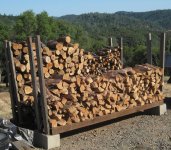
When I finished stacking I went back down to the splitter and started feeling around the hydraulic fittings for leaks. The first thing I noticed is that they were all almost too hot to touch. I don't know if that's normal or not, but it didn't seem to effect the operation of the splitter. I didn't find any stray hydraulic fluid, so I must have spilled a little when I was filling the tank after all. I also noticed that the paint had already been worn off the face of the beam where the wedge had been moving when it was into the wood. Not surprising, but I'll probably use some sort of oil or grease to keep that part from rusting.
So at least for now I'm satisfied that this little splitter will do everything I'll ask of it. The features and controls have been very well thought out, I didn't run into a single issue while I was using it, and the size is such that I can easily manage it by myself. No regrets with the purchase, and I'm already looking forward to my next trip to the wood pile.
I had an hour or so to kill late this afternoon so I dug the Ariens 22 ton log splitter out of the trailer and towed it up to the garage. Again I was impressed that the thing stayed upright on the steep side hills and uneven ramp of the trailer and am feeling a lot more comfortable about moving it around the property.

All it needed was hydraulic oil and fuel and I started with the hydraulic oil. Pretty straight forward: Remove the filler plug (which has a dip stick attached), insert a funnel, and fill the tank. The oil came in a 5 gallon pail with a pour spout in the lid, so I managed to get all of the oil in the tank without spilling any. it's probably worth mentioning that on delivery, the tank plug was threaded in less than finger tight and I consider myself lucky that it was there at all. On the other hand, the plug and dip stick are nicely plated and very sturdy. Like most hydraulic oil I've seen though, it's pretty difficult to tell where the level is on the stick. I found it easiest to wipe the stick clean, dip it, then use my finger to feel where the oil started.

Next up was fuel. I liked the way that the cap to the tank was tethered to the tank, and that the cap threaded around the outside of the filler neck so that water and dirt would be kept out. The cap itself features a built in ratchet mechanism so that it can't be over tightened, and it's marked with an ethanol limit. I use E0 (ethanol free) fuel that has Stabil added for good measure. And I've gotten into the habit of always running my gas engines dry when I'm done so there's no fuel in the carb to gum up the works. I never know how long it's gonna be until the next time I use something. There's also a built in screen to filter fuel as it's added to the tank. Nice.
I was using one of those awful five gallon fuel containers with the government mandated pull back spout and after only a few seconds the tank overflowed. It only holds 1.2 quarts, and if I'd read the manual in advance I'd have been a little more careful. As was, though, the fuel just ran over the outside of the fuel tank, and not all over the rest of the splitter.
With the cap back on it was time to fire it up. There's an in line fuel shut off valve, very handy for running the carb dry at the end of the day. It's easy to reach and worked smoothly. The valve has a single flat blade handle: set it across the fuel line to shut off fuel flow, parallel gets the fuel going. Simple and intuitive, just the way it should be. The valve is right next to the choke handle, which has detents at full on and full off, but which can be set at any position in between. I set it to full on. Right next to that is the ignition switch, marked "0" and "1". Flipped to "1", I was ready to try the pull starter. I didn't know how long the cord was, so I gave it a gentle pull until the piston came up to compression, then a little harder tug to try to start it. Nothing happened. So I gently pulled the cord until it was all the way out, finding a generous amount of cord that would allow a real manly pull. And that's all it took, one manly pull and the motor roared to life. Well stuttered may be more accurate, as it was ninety degrees out and the choke probably wasn't necessary. So I shut it off and the RPMs increased as the engine smoothed out. I didn't notice any surging or bouncing off a governor, and it was quiet enough that I decided not to use ear muffs. No one else was around, but I think you could easily hold a conversation when standing right next to the running motor. During the restarts that occurred the rest of the session I didn't use the choke and all it ever took to start is an easy one handed pull on the cord. We were off to a great start.


With the motor running I cycled the ram half a dozen times, making sure to briefly overpressure the system at each end of travel. If it was gonna leak I wanted it to do it in the garage and not out by the wood pile. That done I shut of the motor and checked the tank level again. It was really low, but then I noticed that the ram was fully extended. Glad I didn't try to add more oil at that point, as I'd have had oil all over the floor, or maybe even burst the tank. So I started the motor back up with a single pull, retracted the ram, verifying that the valve handle stuck in the retract position, then automatically shut itself off when the ram bottomed out in the cylinder. Nice. With the motor off again the level was still a bit low so I poured another few quarts in to bring it up to mid dip stick. I'm guessing it's got a little more than four gallons in it from what is left in the bucket. The dip stick went back in with a few wraps of teflon plumber's tape on the threads, then I ran my fingers over each of the hydraulic lines looking for leaks. Two of them were wet with fluid and it looked like it was coming from where the ferrels were crimped onto the hoses. But I wasn't absolutely certain I hadn't spilled a bit of fluid from the funnel while I was filling the tank, so I used some contact cleaner and a paper towel to clean everything up.
Off we went to the wood pile, where I backed the splitter next to a little pile of wood I'd bucked up a couple weeks previously. I chocked the wheels with bits of wood, unhitched, then moved the RTV around to the side so I could easily reach the bed and stack the splits. All I had in my pile was oak, a mixture of what the locals call white oak and live oak. Most was several seasons old, but some came from a tree that had blown down last winter. There was everything from straight grained chunks to twisted sections cut from just above the roots and quite a few crotches where branches had been trimmed off. Nothing was more than about a foot in diameter, and only about half of it had the ends cut square to the log (I'm still learning).


I figured I'd start with something easy and picked up chunk of wood about eight inches in diameter and the same length. It was heavy for its size, but what I didn't notice is that the grain ran diagonally through the piece. There were no cracks in the cut surface of the piece, so I just centered the wedge on it and hit the lever. It advanced, momentarily stalled, then slowly moved through the piece. I could here the motor strain as it the pump loaded, then ease off as the log broke and the wedge advanced. I was a little surprised at this, but then I noticed the twisted grain, and that the wedge had actually sheared it's way through the log instead of splitting it. I picked up one of the halves and split it, this time watching the wedge move steadily through it with no pauses.
Next I picked up a pretty big piece with a crotch at one end. Even though it was less than a foot in diameter, it was one of the biggest pieces of wood I'll be running into, and I figured if the splitter made it through that I'd be OK with anything else I'd use it for. I took a short movie of the split, and of another piece of the green oak as well. In both shots, the wedge advanced then paused. I flipped the handle back momentarily and when the valve opened again the wedge moved forward to finish the split.
[video]https://www.youtube.com/edit?o=U&video_id=fEthmy7X9rs&feature=vm[/video]
Not a real he-man performance, but good enough for the girls I go with. Those logs were heavy for their size, so I went back to the shop and got my moisture meter. It's a Lignomat mini Ligno E, an Amazon purchase with pretty good ratings. First one I've ever had, and it told me the outside of the wood was at about 8% water, but the inside measured anywhere between 14% and 22%, the highest the thing went. The splits were stringy as well, another sign that the wood was wasn't well seasoned, and probably from last winter's blow down. I'm guessing that the splitter will pick up a little strength as it breaks in as well. In any case, I split another couple dozen pieces in the next hour, breaking them down into two to four inch cross sections. I'm also new to wood burning stoves at this point, and am not really sure what sizes I'll be needing. But I used the splitter enough to get a feel for it, and from what I see so far, I really like it. The ram height is great as I can move wood on and off of the beam without having to bend over or stoop my shoulders. I also learned that a log can fly off the beam if it isn't positioned properly, so next time I'll give myself a little more room between the splitter and the wood pile so I can stand next to the ram instead of the wedge. The log cradles do a great job of catching the splits as they come off as well. As mentioned earlier, the control valve is easy to reach and works without any fuss. I didn't have any issues with the splitter moving or the beam tipping unexpectedly, there was no exhaust smell where I was standing, nothing rattled and the only noise was the engine and pump working. I used the wood pile to hold half the split while I worked over the other half, and can see that a table near the wedge would be handy for horizontal splitting. I don't like the idea of attaching it to the beam though, as I'm pretty sure something like that would interfere with splitting large logs and when the splitter is used vertically. I also learned that twisted grain will produce splits shorter than the log they started from, and there were a fair number of slivers and such that'll be great for kindling.
With the RTV full I went back up the hill and set up another temporary rack to hold the splits. I ended up with a stack about eight feet long and three high, all from about an hour's work. I've not done much splitting with an axe or maul, but I've done enough to know I'd have much less than that after an hour, and been finished for the day as well. As it was, I wasn't sore anywhere (my back will start talking to me with much bending over work at all) and plenty of poop left to stack the wood.

When I finished stacking I went back down to the splitter and started feeling around the hydraulic fittings for leaks. The first thing I noticed is that they were all almost too hot to touch. I don't know if that's normal or not, but it didn't seem to effect the operation of the splitter. I didn't find any stray hydraulic fluid, so I must have spilled a little when I was filling the tank after all. I also noticed that the paint had already been worn off the face of the beam where the wedge had been moving when it was into the wood. Not surprising, but I'll probably use some sort of oil or grease to keep that part from rusting.
So at least for now I'm satisfied that this little splitter will do everything I'll ask of it. The features and controls have been very well thought out, I didn't run into a single issue while I was using it, and the size is such that I can easily manage it by myself. No regrets with the purchase, and I'm already looking forward to my next trip to the wood pile.
Last edited:
